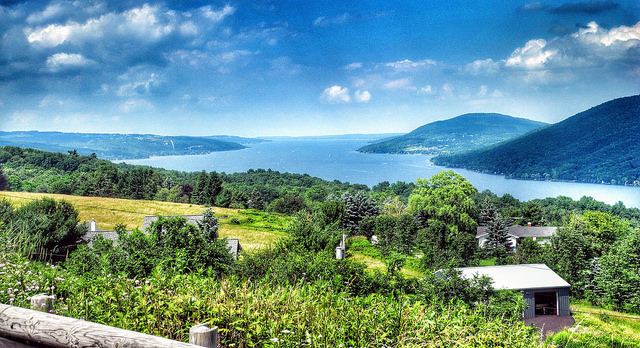Canandaigua Lake Facts
 The pride and joy of all Canandaigua is the lake. The third largest of one of the eleven Finger Lakes, its scenic beauty prompted one author to deem it "the Gem of the Inland Lakes." From the romantic steamboat era to our modern windsurfing times, it has provided residents and tourists with endless hours of recreation, prosperous livelihoods and treasured moments of nature's quiet solitude. The splendor of the lake and its surrounding rolling hills combine to make this area truly one of the most beautiful places in the United States. It is not hard to imagine why the Senecas and countless others since then have chosen to settle in Canandaigua. The lake is the community's most important asset and an essential part of its identity. It serves as a source of drinking water for over 70,000 area residents. Tourism is one of the area's most important economic development activities, with the recreational opportunities of the lake being the principal attraction for vacationers.
The pride and joy of all Canandaigua is the lake. The third largest of one of the eleven Finger Lakes, its scenic beauty prompted one author to deem it "the Gem of the Inland Lakes." From the romantic steamboat era to our modern windsurfing times, it has provided residents and tourists with endless hours of recreation, prosperous livelihoods and treasured moments of nature's quiet solitude. The splendor of the lake and its surrounding rolling hills combine to make this area truly one of the most beautiful places in the United States. It is not hard to imagine why the Senecas and countless others since then have chosen to settle in Canandaigua. The lake is the community's most important asset and an essential part of its identity. It serves as a source of drinking water for over 70,000 area residents. Tourism is one of the area's most important economic development activities, with the recreational opportunities of the lake being the principal attraction for vacationers.
Concerns about the preservation of the lake as a resource has lead to the formation of the Canandaigua Lakes Watershed Task Force, a diverse group of "stakeholders" actively involved in efforts to protect the quality of the lake. With six townships in two counties bordering Canandaigua Lake, its management requires intergovernmental and interagency cooperation. Because less than 3% of the lake's shoreline is in public ownership, enhancing and maintaining public access to the lake had been an important public policy issue as further development of the lakefront areas has been proposed in recent years.
Skenoh Island (formerly Squaw Island) is an 11,000 year old island located at the north end of the lake. It is known to be New York State's smallest Fish and Wildlife Management Area and one of the two known islands in the eleven Finger Lakes. Legend states that the island was used to hide the Seneca women and children during the Sullivan Expedition against the Six Nations in 1779. The island is one of the unique and few places on earth that makes water biscuits, an extremely rare form of carbonate of lime deposits on pebble. A feathery light rock calcified from algae, filtered by sand and pond scum are hard in the water but crumble if allowed to dry out. The island has been eroding rapidly from the forces of ice, wind, water current and development changing the wave patterns. In 1977, New York State Department of Environmental Conversation installed a cedar log buffer around the island to help preserve it. Its size was approximately two acres in 1853, it shrunk by 75% in 162 years to one quarter acre in 1971. Today only 55 feet by 145 feet of the island remains. A newly formed group called the Squaw Island Preservation Society has raised citizen support to protect the island and its unique place in science after state officials said they would no longer maintain it. Work on the preservation was completed in Summer 2001.
Physical characteristics of the lake are:
- 16.57 square miles (10,600 acres) of surface area
- 15.8 miles long
- 1.5 miles wide
- 276 feet deep
- 688 feet above sea level
- 35.9 miles of shoreline
- 34.7 (97%) private
- 1.2 (3%) public
- 429 billion gallons capacity
The lake has an abundance of trout, bass, perch, bullhead and several other common fish species for fishing.
The preceeding information is credited to "Visitor's Guide to Historic Canandaigua", published by the Ontario County Historical Society. 2001, and edited by Ray Henry in 2014.
